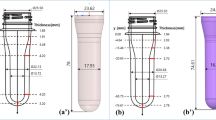Abstract
In these last years, the demand of shaped aluminium bottles and cans was continuously growing. The main problem is related to the fact that normally these objects have very thin thickness and a high strain-hardened material due to the deforming production steps (deep drawing and ironing). In the present paper, a study about the residual formability of cylindrical can is reported. In particular, a first characterization of the flow stress of the ironed component and the identification of the maximum deformation reachable with the hydroforming process were carried out. On the base of these preliminary results, the feasibility of hydroforming aluminium can, namely a small bottle for soft drink, has been investigated. The process is similar to tube hydroforming, even if the bottom part of the can is closed and air is used instead of liquid. The main problems to be solved were related with the possible breakages of the cylindrical body during hydroforming. The process success depends on the material characteristics, the diameter and thickness of the preformed cylindrical body, the shape, the geometry and the dimensions of the final part and the media pressure. The research aims to study the process feasibility and to prove the ability of the simulation software in forecasting the material behaviour. All the simulation phases are supported by experimental tests aiming at validating the finite element method model and to realize sound prototypes of Al soft drink bottles. In such a way, it is possible to have a reliable tool to help the designer in optimizing the process and in identifying new feasible shapes.
Similar content being viewed by others
References
Music O, Allwood JM (2011) Flexible asymmetric spinning. Ann CIRP 60:319–322
Brekelmans WAM, Mulders LHG, Ramaekers JAH, Kals JAG (1988) The coining process: analytical simulations evaluated. Ann CIRP 37(1):235–238
Vollertsen F, Prange T, Sander M (1999) Hydroforming: needs, developments and perspectives. In: Geiger M (Ed.), Proceedings of the 6th ICTP, Nuremberg, Germany: 1197–1210
Zhang SH, Danckert J (1998) Development of hydromechanical deep drawing. J Mater Process Technol 83:14–25
Schmoeckel D, Hielscher C, Huber R (1999) Metal forming of tubes and sheets with liquid and other flexible media. CIRP Ann 48:497–513
Kocańda A, Sadłowska H (2008) Automotive component development by means of hydroforming: a review. Arch Civ Mech Eng 8(3):55–57
Braedel M, Palaniswamy H, Altan T (2005) Estimation of optimal blank holder force and pressure trajectory in sheet hydroforming with punch (SHF-P) hydromechanical deep drawing (HDD). ERC/NSM Report 05-R-21, OH, USA
Langa LH, Wang ZR, Kang DC, Yuan SJ, Zhang SH, Danckert J, Nielsen KB (2004) Hydroforming highlights: sheet hydroforming and tube hydroforming. J Mater Process Technol 151:165–177
Onder E, Tekkaya AE (2008) Numerical simulation of various cross sectional workpieces using conventional deep drawing and hydroforming technologies. Int J Mach Tool Manuf 48:532–542
Bortot P, Ceretti E, Fiorentino A, Giardini C (2007) Hydromechanical deep drawing of funerary vases: a suitable alternative to the traditional forming processes. Key Eng Mater 344:485–492
Ahmetoglu M, Altan T (2000) Tube hydroforming: state of art and future trends. J Mater Process Technol 98:25–33
Oh SH, Jeon BH, Kim HY, Yang JB (2006) Applications of hydroforming processes to automobile parts. J Mater Process Technol 174:42–45
Jarathearanat S, Altan T (1999) Successful tube hydroforming. TPJ Tube Pipe J (USA) 10(8):46–52
Fiorentino A., Braga D., Ceretti E., Giardini C. (2008) Use of the conjugate gradient method for the optimization of sheet hydroforming processes. Proceeding of the 6° CIRP ICME 08. Napoli, Italia
Zhu J (1997) A new approach to preform design in shell nosing. J Mater Process Technol 63:640–644
Kang BS, Lee JH, Kim SH (1997) Development of a methodology to form net-shape nosing shells by the backwards tracing scheme of the rigid-plastic FEM. Int J Mach Tool Manuf 37:737–750
Attanasio A, Ceretti E, Giardini C (2005) Comparison between simulative and experimental results of necking operations on aluminium can. Proceedings of the 8th ICTP: 571–572
Yoon E, Kong H, Kwon O, Oh J (1997) Evaluation of frictional characteristics for a pin-on-disk apparatus with different dynamic parameters. Wear 203–204:341–349
Ceretti E, Fiorentino A, Giardini C (2008) Process parameters influence on friction coefficient in sheet forming operations. Int J Mater Form 1:1219–1222
Banabic D, Barlat F, Cazacu O, Kuwabara T (2010) Advances in anisotropy and formability. Int J Mater Form 3:165–189
Author information
Authors and Affiliations
Corresponding author
Rights and permissions
About this article
Cite this article
Ceretti, E., Attanasio, A., Fiorentino, A. et al. Aluminium can shaping by hydroforming: simulative feasibility study and prototype production. Int J Adv Manuf Technol 68, 1797–1807 (2013). https://doi.org/10.1007/s00170-013-4978-x
Received:
Accepted:
Published:
Issue Date:
DOI: https://doi.org/10.1007/s00170-013-4978-x




